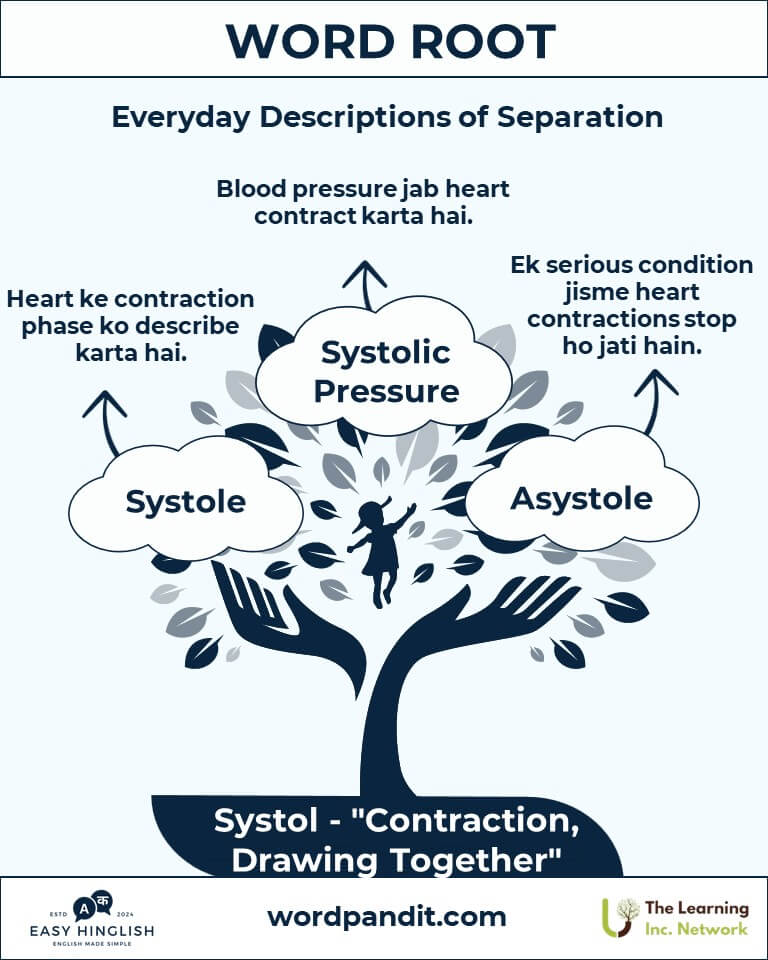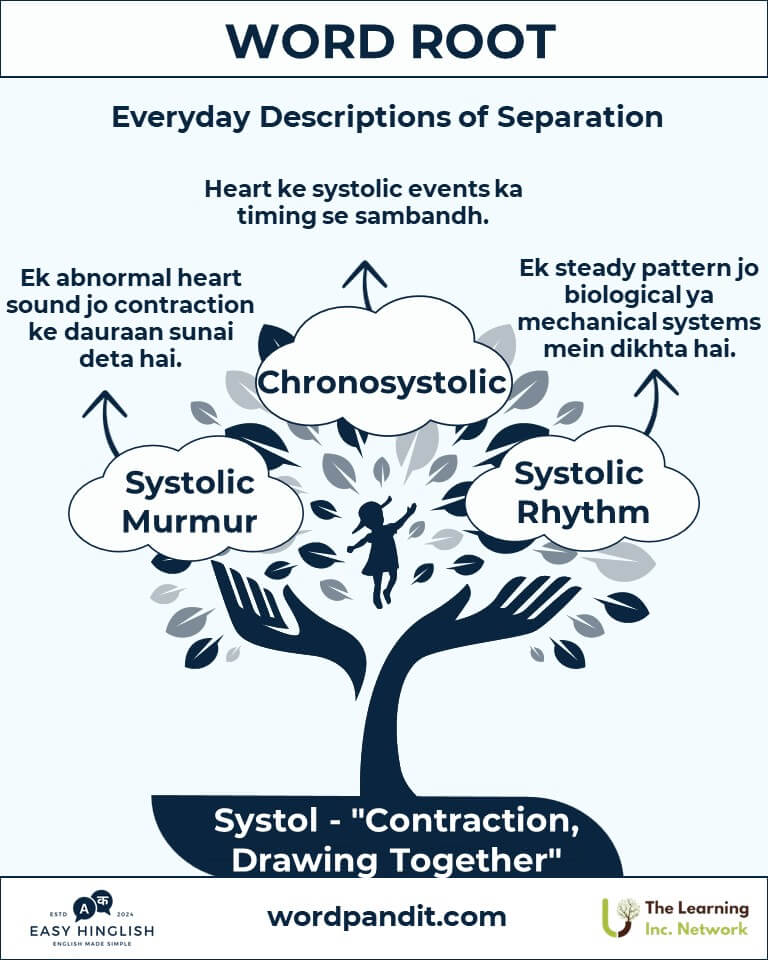Systol: The Rhythmic Pulse of Contraction in Language and Science
(Systol: Bhaasha aur Vigyaan mein Sankuchan ka Rhythmic Pulse - सिस्टोल: भाषा और विज्ञान में संकुचन का तालबद्ध स्पंदन)
Byline: Discover the dynamic significance of the root "Systol," derived from the Greek word "systole," meaning "contraction." This word root pulsates through the fields of medicine, biology, and linguistics, encapsulating the essence of rhythmic activity essential to life and expression।

Table of Contents
- Introduction: The Power of Systol
- Etymology and Historical Journey
- Mnemonic: Unlocking the Power of Systol
- Common Systol-Related Terms
- Systol Through Time
- Systol in Specialized Fields
- Illustrative Story: Systol in Action
- Cultural Significance of the Systol Root
- The Systol Family Tree
- FAQs About the Systol Root
- Test Your Knowledge: Systol Mastery Quiz
- Conclusion: The Living Pulse of Systol
Introduction: The Power of Systol
(Systol ki Shakti - सिस्टोल की शक्ति)
Picture the rhythmic beat of a heart, contracting to pump life-giving blood throughout the body। The root "Systol" (pronounced SIS-toll) embodies this vital motion, capturing the essence of contraction and rhythmic activity। Originating from the Greek word "systole," meaning "a drawing together" or "contraction," this root forms the foundation of terms critical in medicine, physiology, and beyond।

Etymology and Historical Journey
(Utpatti aur Itihaas - उत्पत्ति और इतिहास)
- Greek Origin: "Systol" root ancient Greek word "systole" se nikla hai, jiska matlab hai "to draw together" ya "compress" करना।
- Medical Evolution: Yeh term medical lexicon mein heart ke rhythmic contraction ko denote karne ke liye evolve hui, jo cardiovascular terminology ka ek important part ban gayi।
Mnemonic: Unlocking the Power of Systol
(Mnemonic ke Zariye Systol Ko Yaad Rakhein - मेमोनिक के जरिए सिस्टोल को याद रखें)
To remember "Systol," envision the heart squeezing in perfect rhythm, pulling life forward with every beat।
Mnemonic Device: “Systol syncs the pulse of life, contracting with purpose।”
Common Systol-Related Terms
(Systol se Jude Common Shabd - सिस्टोल से जुड़े सामान्य शब्द)
- Systole (सिस्टोल): The contraction phase of the heart’s cycle, when blood is pumped out of the chambers।
Example: "During systole, the ventricles contract to propel blood into the arteries।" - Systolic (सिस्टोलिक): Pertaining to systole, often used to describe blood pressure during heart contractions।
Example: "A systolic blood pressure of 120 is considered normal।" - Asystole (असिस्टोल): A medical condition marked by the absence of heart contractions (cardiac arrest)।
Example: "The patient was in asystole and required immediate resuscitation।" - Systolic Murmur (सिस्टोलिक मर्मर): An abnormal heart sound occurring during systole, often indicating valve issues।
Example: "The doctor detected a systolic murmur during the physical exam।"
Systol Through Time
(Samay ke Saath Systol ka Safar - समय के साथ सिस्टोल का सफर)
- Ancient Greek Medicine: Physicians used "systole" to describe various bodily contractions, particularly in the heart।
- Renaissance & Enlightenment: With advancements in anatomy, "systole" became a key term in cardiovascular research।
- Modern Medicine: Today, systolic blood pressure readings are critical for diagnosing heart health।
Systol in Specialized Fields
(Vishesh Kshetron Mein Systol ka Mahatva - विशिष्ट क्षेत्रों में सिस्टोल का महत्व)
- Cardiology:
- Systole: The contraction phase of the heart, critical in measuring blood pressure।
- Systolic Murmur: Abnormal sound that can indicate heart valve dysfunction।
- Linguistics:
- Systole in Rhetoric: In poetry, "systole" referred to the shortening of syllables for rhythm।
- Technology:
- AI in Healthcare: Machine learning algorithms now use systolic readings for predictive modeling of heart conditions।
Illustrative Story: Systol in Action
(Ek Kahani jo Systol ka Mahatva Dikhati Hai - एक कहानी जो सिस्टोल का महत्व दिखाती है)
Dr. Elena Rivera, a cardiologist, was faced with a patient suffering from dangerously high systolic blood pressure। Through careful monitoring and the use of AI technology analyzing systolic patterns, she identified an underlying issue—a valve defect। A successful surgery not only restored the patient’s health but highlighted the life-saving importance of understanding systolic rhythms।
Cultural Significance of the Systol Root
(Systol Root ka Sanskritik Mahatva - सिस्टोल रूट का सांस्कृतिक महत्व)
The rhythmic nature of "systole" resonates beyond medicine, symbolizing balance and harmony in life। Many cultures view the heartbeat as a metaphor for life's natural cycles, emphasizing contraction and expansion as universal principles।

The Systol Family Tree
(Systol Family ke Related Words - सिस्टोल परिवार के संबंधित शब्द)
- Stol (to place, send):
- Epistolary: Relating to letters or correspondence।
- Diastol (expansion):
- Diastole: The phase of relaxation in the heart’s cycle।
- Chron (time):
- Chronosystolic: Pertaining to the timing of systolic events।

FAQs About the Systol Word Root
(Systol Root se Jude Prashn aur Uttar - Systol
Q1: Systol ka kya matlab hai?
A: "Systol" ka matlab hai "contraction" ya "drawing together." Yeh root Greek word "systole" se aaya hai, jo medically heart ke contraction phase ko describe karta hai. Linguistics mein, yeh root shortening aur compressing concepts ko represent karta hai.
Q2: Systole aur diastole mein kya difference hai?
A:
• Systole: Heart ka contraction phase, jab blood ventricles se pump hota hai.
• Diastole: Heart ka relaxation phase, jab blood ventricles mein wapas bharte hain.
Dono phases ek rhythmic cycle ko complete karte hain jo cardiovascular system ke liye zaruri hai.
Q3: Systolic pressure ka kya matlab hota hai?
A: Blood pressure ka systolic reading woh pressure hai jo arteries par hota hai jab heart contract karta hai. Normal systolic range 90-120 mmHg hoti hai.
Q4: Asystole kya hota hai?
A: Asystole ek medical condition hai jisme heart contractions completely absent hote hain, jo "flatline" ya cardiac arrest kehlata hai. Yeh ek medical emergency hai jo immediate treatment demand karti hai.
Q5: Kya "Systole" non-medical context mein use hota hai?
A: Haan, linguistics aur rhetoric mein "systole" syllables ke contraction ko represent karta hai. Poetry aur speech mein iska istamaal rhythmic patterns banane ke liye hota tha.
Test Your Knowledge:Systol Mastery Quiz
(Systol Quiz ke Zariye Apne Gyaan ko Test Karein - Systol
1. "Systole" kya describe karta hai?
2. Systolic blood pressure ka normal range kya hai?
3. Konsa term heart contractions ki absence ke liye use hota hai?
4. "Systolic Murmur" ka kya matlab hai?
5. Diastole aur Systole mein kya antar hai?
Conclusion: The Living Pulse of Systol
(Systol ka Jeevant Spandan - सिस्टोल का जीवंत स्पंदन)
The root "Systol" embodies the essential act of contraction, vital to both language and life। From the rhythmic beating of the heart to its linguistic origins, it represents motion, energy, and harmony। As our understanding of this root deepens, its relevance in medicine, science, and culture continues to expand, connecting us to the timeless rhythm of life।








